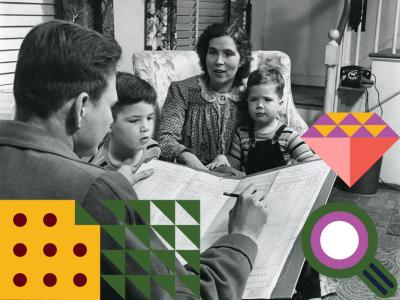
April 1, 2022—On this day 72 years ago, the headlines in The Knoxville News-Sentinel were echoes of the mid-20th century economic and population boom occurring across the United States—“Traffic Snarled Throughout the City,” “City Building Far Ahead for Quarter: Permits $3,000,000 Over Period in ’49,” “First Baby of April Fool’s Day Arrives at Baptist at 12:05 a.m.,” among others. While local newspapers took daily snapshots of burgeoning, post-World War II communities, between April 1 and June 30, 1950, the U.S. Census Bureau stitched together a panoramic view of the nation—the 17th decennial census or, more simply put, the 1950 Census.
Today, the 1950 Census meets its 72-year withholding threshold and is set to be released to the public, not only advancing the most recent census records available by a decade but also providing historical data for the start of what would become the Baby Boomer generation.
What is unique about the 1950 Census? How can you search it? Here’s what you need to know:
- The 1950 Census will be available to search on the following resources: Archives.gov, FamilySearch, and Ancestry. Notably, the National Archives and Records Administration is making a bulk download of the full dataset available to researchers through Amazon Web Services' (AWS) Registry of Open Data.
- At Archives.gov, you will be able to search the 1950 census by name and location via an index developed by AWS’s artificial intelligence/optical character reader (AI/OCR), a first for census indexing. Note: This OCR technology is not expected to be 100% accurate. You can also locate persons by identifying their enumeration district.
- The 1950 Census marks the last one that was enumerated from door-to-door. In 1950, mail-in forms were tested in parts of Michigan and Ohio, the results from which were viewed as accurate and efficient.
- Take a moment to familiarize yourself with the 1950 Census forms. More sample questions were asked than in 1940, and there are additional questions at the bottom of each page. Only 6 persons out of the 30 on each page were selected to answer the additional questions.
- Locally, it is interesting to note that residents of Oak Ridge, Tennessee, will appear in the 1950 Census for the first time, given their “Secret City” was erected between 1940 and 1950.
Do you have additional questions about the 1950 Census or need assistance searching its pages? Please know that archivists and librarians at the East Tennessee History Center are ready to help. Make plans to visit the past today!
Sources
"1950 Census Records," National Archives and Records Administration [https://www.archives.gov/research/census/1950].
The Knoxville News-Sentinel, Knoxville, TN, April 1, 1950.
"Unified Census Enumerated District Finder" by Stephen Morse and Joel Weintraub, [https://stevemorse.org/census/unified.html].
Ancestry (Library Edition)
Search the 1950 Census via Ancestry (Library Edition); access is available at the East Tennessee History Center.

FamilySearch
Search the 1950 Census via FamilySearch.